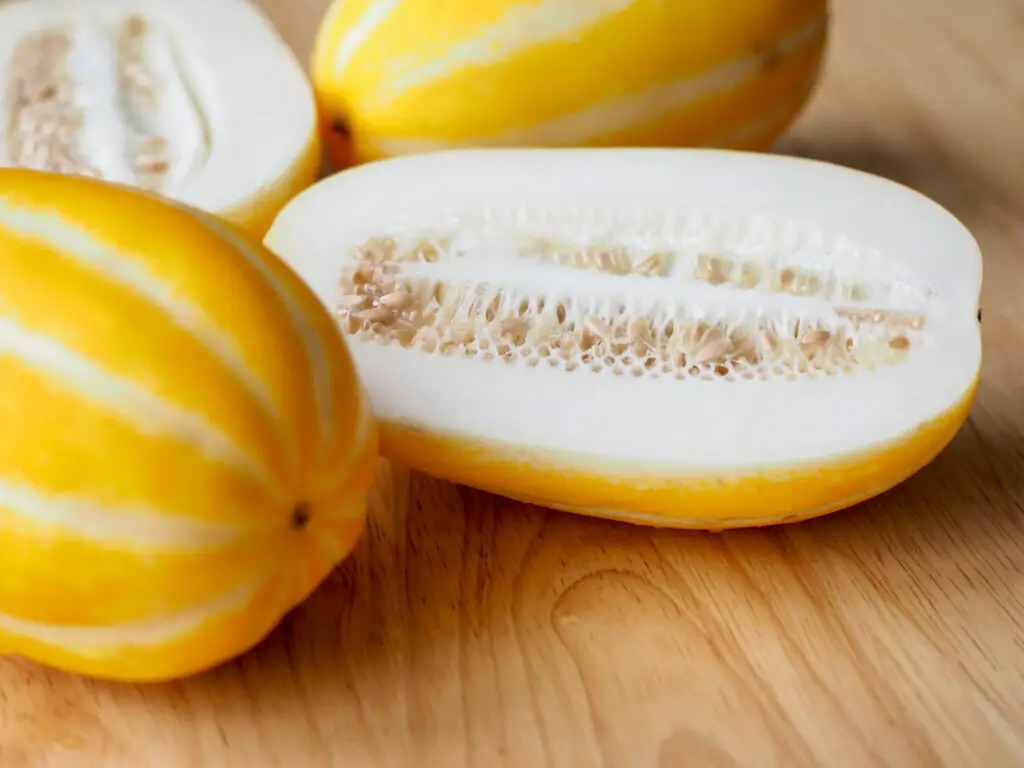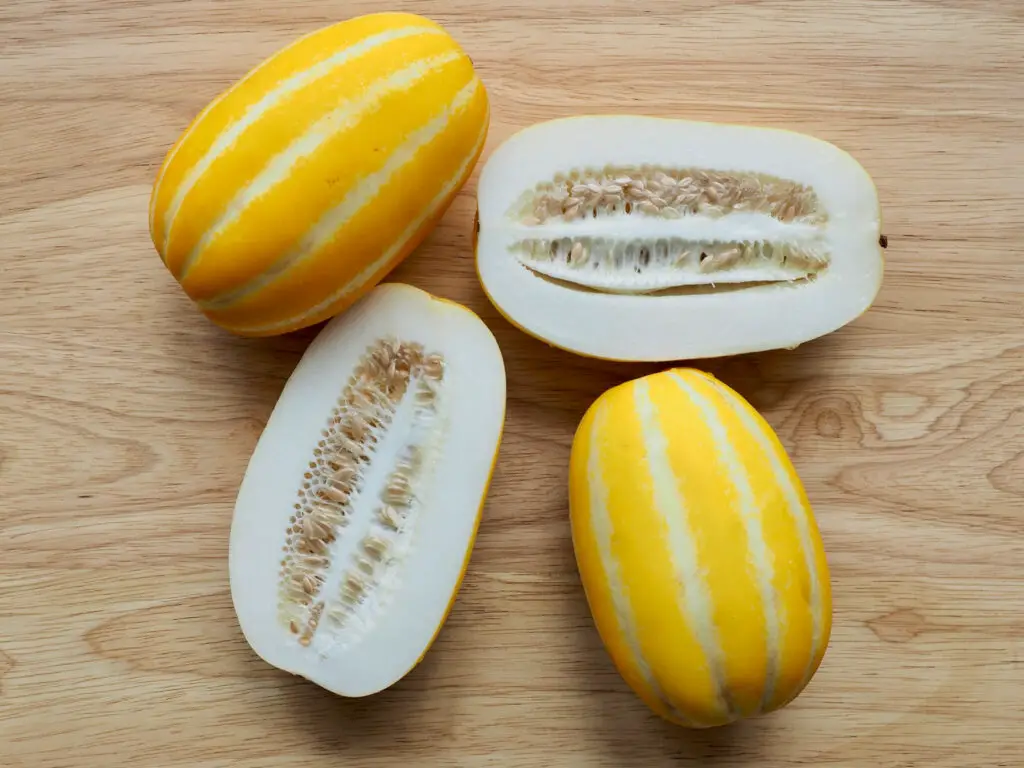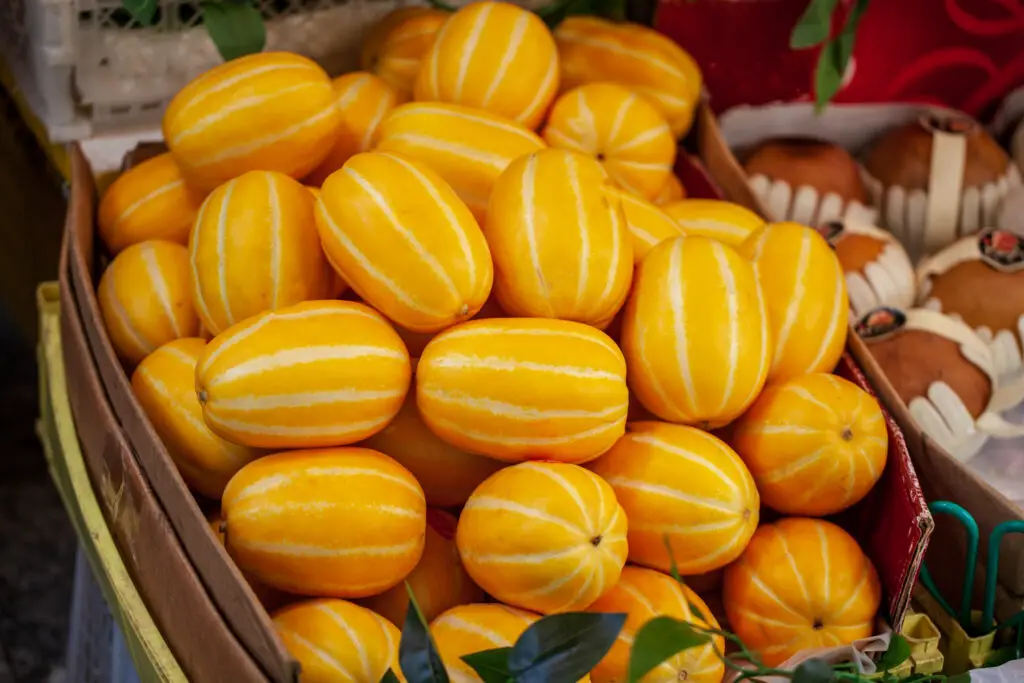As an Amazon Associate I earn from qualifying purchases. Please read the disclaimer for more info.
Have you ever heard of a Korean Melon? This mysterious and elusive bright yellow fruit is one of the most sought-after delicacies in Asian cuisine, with its origins stretching back centuries.
But what exactly is it? Where does it come from, and what does it taste like?
In this guide to Korean Melon, we will explore the history and flavor of this exotic and delectable fruit so that you can get to know one of the most delicious treats in Asia.
Along with the golden Hami melon, it is one of my favourite summer fruits.
Related: 29 Yellow Fruits: Nature’s Golden Treats
What is Korean Melon?

Korean Melon, also known as Chamoe or Oriental Melon, is a delightfully sweet fruit that hails from the southern regions of Korea.
Easily recognizable for its vibrant yellow hue and oblong shape, this juicy firm melon is enjoyed by locals as a refreshing snack who eat Korean melon during the hot summer months.
With a texture akin to a pear and a taste reminiscent of a cross between a honeydew melon and a cantaloupe, Oriental melons are a unique and tasty addition to fruit or green salads.
Plus, it’s low in calories and high in nutrients, making it a healthy choice for anyone looking to satisfy their sweet tooth without the added guilt.
Whether you slice it into bite-sized white flesh pieces or enjoy it as the entire melon, edible seeds, and all, Korean Melon is a delicious way to expand your fruit horizons.
Related: The Exotic and Nutritious Yellow Dragon Fruit
What is The History of the Oriental Melon?
Also known as the Japanese Sweet Melon, the Oriental Melon has a rich history with roots in ancient Persia and Eastern India, making its way to China via the Silk Road.
This delectable melon then went to Korea during the Joseon Dynasty, where it was highly prized and widely cultivated.
Derived from the muskmelon family, Korean Melons were grown in the countryside of Korea for centuries and were widely consumed by Korean royalty.
In the modern-day, these East Asia delicacies are still highly sought after and exported worldwide due to their unique flavor and texture.
With its remarkable qualities and deep-rooted cultural significance, it’s no wonder why Korean Melon continues to capture the hearts (and taste buds) of people all around the globe.
What are the Health Benefits of Korean Melon?

With its high nutritional content, Oriental Melon offers a wide range of health benefits, making it an excellent addition to any diet.
It is a rich source of vitamins and minerals. It is high in vitamin C, which boosts the immune system, and vitamin A, which is good for vision and improving skin complexion by boosting collagen production.
The fruit also contains essential minerals like potassium, which helps regulate blood pressure, magnesium which is vital for bone health; and calcium which helps maintain healthy teeth and bones.
Korean Melon is also a good fiber source, a regulation booster for the digestive tract aiding regular bowel movements.
The ripe fruit is also rich in antioxidants that help fight inflammation, boost heart health, and reduce the risk of chronic diseases.
What Does Korean Melon Taste Like?
Have you ever tasted Korean melon? If not, you’re missing out on a delicious and unique flavor experience!
The melons have a thin rind with a bitter nature and a juicy, crunchy interior with small seeds.
They have a sweet and refreshing taste, similar to a mix of honeydew and cucumber, with hints of pear and banana.
When you bite into a Korean melon, you’ll experience a burst of juicy sweetness that will leave you wanting more, and it’s no wonder why it’s a popular fruit in Korea and Japan during the summer season.
Growing Korean Melon

Korean melons are relatively easy to grow and can produce a bountiful harvest with the right care and attention.
You can grow Korean Melons from seeds, with the melons preferring warm climates with nutrient-rich, well-draining soil. Here are a few tips:
- Seeds should be sown directly into the ground when the rich soil has warmed, planted 1 inch deep, and 3-4 feet apart from each other.
- The plants need 1 inch of water per week and regular fertilizer applications throughout the growing season.
- Train vines to grow vertically on trellises or support structures; prune away any suckers or lateral shoots below fruits for better production.
- Monitor for pests regularly and use natural pest controls; harvest melons when the skin is yellow, there is a hollow sound when tapped lightly, there is a slight “give” at the stem end, and when it produces a distinctive and pleasant fragrance.
Ideas for Oriental Melon Recipes
Korean melons are a popular summer fruit in South Korea and are often eaten raw for their juicy, sweet taste and refreshing texture.
One popular Korean melon recipe is a simple melon salad, which combines diced melon with thinly sliced cucumber and a light dressing made of rice vinegar, soy sauce, and sesame oil.
Another favorite is a chilled melon soup, made by pureeing melon with yogurt, honey, and a pinch of salt.
For a sweet treat, try making Korean melon ice cream, which involves blending melon with heavy cream, sugar, and a dash of vanilla extract and freezing the mixture in an ice cream maker.
No matter how you enjoy Korean melon, its unique flavor, and versatility make it a delicious addition to any summer meal.
Related:
- 39 Exotic Asian Fruits You Need to Try at Least Once!
- 13 Delicious Types of Papaya
- African Pear: The Unique African Fruit
FAQs
Korean melons are derived from the muskmelon family, slightly different from traditional watermelon or cantaloupe. Whereas watermelon and cantaloupe have thick rinds and seeds, Korean melons have thin, smooth exteriors and small edible seeds. Their sweet and refreshing taste also sets them apart from other types of melon.
No, Oriental melons contain relatively low amounts of sugar compared to other fruits. They have a natural sweetness from their juice content, but the sugar content is much lower than that of an apple or banana.
Yes! As mentioned earlier, Korean melons are rich in vitamins and minerals that can benefit your overall health. They also contain dietary fiber, which helps regulate blood glucose levels and aid digestion. Korean melon is a great choice for those looking to add flavor and nutrition to their diet.
There are many creative ways to use Korean melons in the kitchen! Try making a savory melon salsa by combining diced melon with cilantro, jalapeño, red onion, and lime juice. Add diced melon to fruit salads or yogurt parfaits for a nutritious and delicious snack.
Korean melons can be found in most well-stocked supermarkets and international food stores. If you’re having trouble finding it, you may also be able to order it online from specialty markets or Asian grocers. In the summer months, you may even be able to find them at local farmer’s markets.
To ensure you get the most out of your Korean melons, it’s best to keep them refrigerated. If you plan on consuming them within a few days, they can be kept in the refrigerator. If you’re looking to store them for longer, putting them in the freezer is best. To freeze Korean melon, cut it into cubes or slices and place them into an airtight container before placing them in the freezer. This way, you can enjoy the sweet taste of Korean melon all year round!
When stored correctly, fresh Korean melons will last up to a week in the refrigerator. Frozen Korean melons can last up to two months in the freezer. It’s important to note that the texture and flavor of frozen melons may change over time, so it’s best to use them as soon as possible.
Yes! The thin skin of an Oriental melon is completely edible and adds an extra layer of flavor to dishes. However, it’s important to ensure the melon is washed properly before consumption to avoid contaminants.

